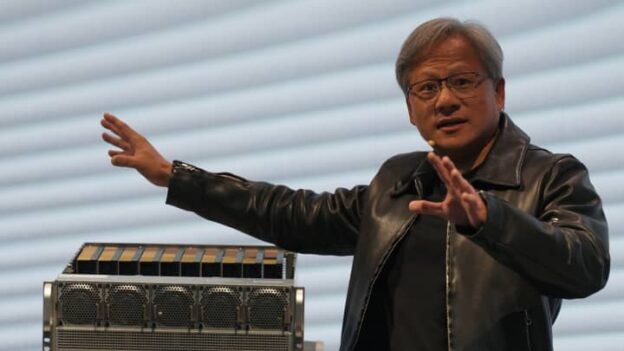GH200-powered centers represent 200 exaflops of AI performance driving scientific innovation.
Dozens of new supercomputers for scientific computing will soon hop online, powered by NVIDIA’s breakthrough GH200 Grace Hopper Superchip for giant-scale AI and high performance computing.
The NVIDIA GH200 enables scientists and researchers to tackle the world’s most challenging problems by accelerating complex AI and HPC applications running terabytes of data.
At the SC23 supercomputing show, NVIDIA today announced that the superchip is coming to more systems worldwide, including from Dell Technologies, Eviden, Hewlett Packard Enterprise (HPE), Lenovo, QCT and Supermicro.
Bringing together the Arm-based NVIDIA Grace CPU and Hopper GPU architectures using NVIDIA NVLink-C2C interconnect technology, GH200 also serves as the engine behind scientific supercomputing centers across the globe.
Combined, these GH200-powered centers represent some 200 exaflops of AI performance to drive scientific innovation.
HPE Cray Supercomputers Integrate NVIDIA Grace Hopper
At the show in Denver, HPE announced it will offer HPE Cray EX2500 supercomputers with the NVIDIA Grace Hopper Superchip. The integrated solution will feature quad GH200 processors, scaling up to tens of thousands of Grace Hopper Superchip nodes to provide organizations with unmatched supercomputing agility and quicker AI training. This configuration will also be part of a supercomputing solution for generative AI that HPE introduced today.
“Organizations are rapidly adopting generative AI to accelerate business transformations and technological breakthroughs,” said Justin Hotard, executive vice president and general manager of HPC, AI and Labs at HPE. “Working with NVIDIA, we’re excited to deliver a full supercomputing solution for generative AI, powered by technologies like Grace Hopper, which will make it easy for customers to accelerate large-scale AI model training and tuning at new levels of efficiency.”
Next-Generation AI Supercomputing Centers
A vast array of the world’s supercomputing centers are powered by NVIDIA Grace Hopper systems. Several top centers announced at SC23 that they’re now integrating GH200 systems for their supercomputers.
Germany’s Jülich Supercomputing Centre will use GH200 superchips in JUPITER, set to become the first exascale supercomputer in Europe. The supercomputer will help tackle urgent scientific challenges, such as mitigating climate change, combating pandemics and bolstering sustainable energy production.
Japan’s Joint Center for Advanced High Performance Computing — established between the Center for Computational Sciences at the University of Tsukuba and the Information Technology Center at the University of Tokyo — promotes advanced computational sciences integrated with data analytics, AI and machine learning across academia and industry. Its next-generation supercomputer will be powered by NVIDIA Grace Hopper.
The Texas Advanced Computing Center, based in Austin, Texas, designs and operates some of the world’s most powerful computing resources. The center will power its Vista supercomputer with NVIDIA GH200 for low power and high-bandwidth memory to deliver more computation while enabling bigger models to run with greater efficiency.
The National Center for Supercomputing Applications at the University of Illinois Urbana-Champaign will tap NVIDIA Grace Hopper superchips to power DeltaAI, an advanced computing and data resource set to triple NCSA’s AI-focused computing capacity.
And, the University of Bristol recently received funding from the UK government to build Isambard-AI, set to be the country’s most powerful supercomputer, which will enable AI-driven breakthroughs in robotics, big data, climate research and drug discovery. The new system, being built by HPE, will be equipped with over 5,000 NVIDIA GH200 Grace Hopper Superchips, providing 21 exaflops of AI supercomputing power capable of making 21 quintillion AI calculations per second.
These systems join previously announced next-generation Grace Hopper systems from the Swiss National Supercomputing Centre, Los Alamos National Laboratory and SoftBank Corp.
GH200 Shipping Globally and Available in Early Access from CSPs
GH200 is available in early access from select cloud service providers such as Lambda and Vultr. Oracle Cloud Infrastructure today announced plans to offer GH200 instances, while CoreWeave detailed plans for early availability of its GH200 instances starting in Q1 2024.
Other system manufacturers such as ASRock Rack, ASUS, GIGABYTE and Ingrasys will begin shipping servers with the superchips by the end of the year.
NVIDIA Grace Hopper has been adopted in early access for supercomputing initiatives by more than 100 enterprises, organizations and government agencies across the globe, including the NASA Ames Research Center for aeronautics research and global energy company TotalEnergies.
In addition, the GH200 will soon become available through NVIDIA LaunchPad, which provides free access to enterprise NVIDIA hardware and software through an internet browser.
Learn more about Grace Hopper and other supercomputing breakthroughs by joining NVIDIA at SC23.
https://blogs.nvidia.com/blog/gh200-grace-hopper-superchip-powers-ai-supercomputers/





